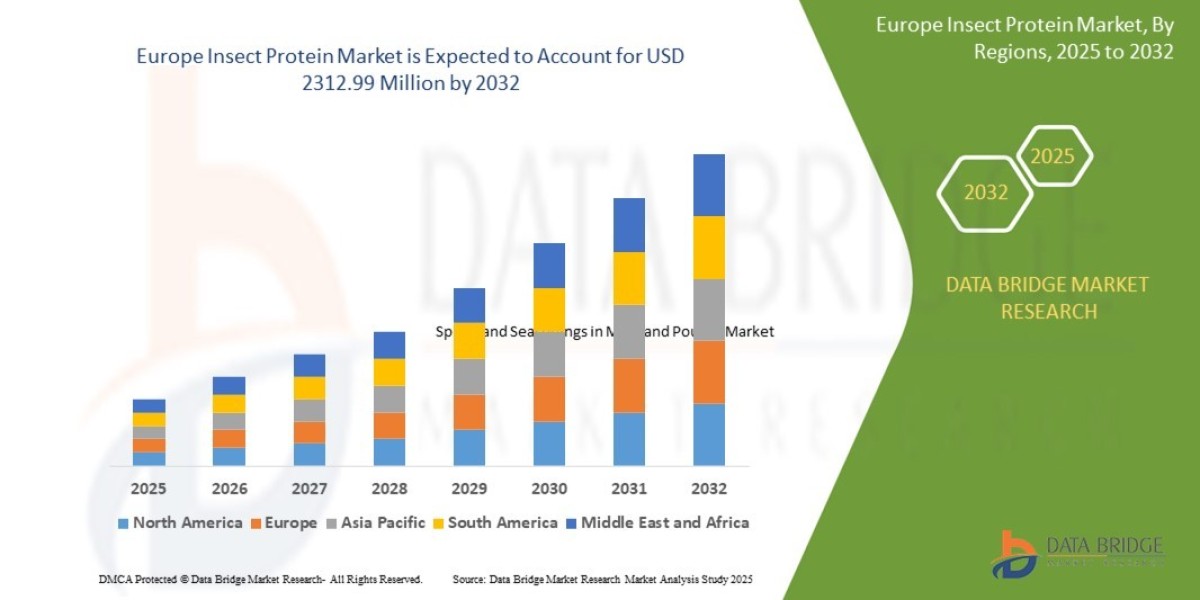Introduction
The Europe insect protein market is rapidly emerging as one of the most innovative and sustainable segments within the global food and feed industry. As demand for alternative protein sources accelerates, insect protein is gaining recognition as a viable solution to address food security, environmental sustainability, and the growing consumption of protein-rich products. With Europe at the forefront of regulatory support, technological innovation, and consumer awareness, the region plays a pivotal role in shaping the global narrative of insect-based nutrition.
Insect protein is valued for its high nutritional content, containing essential amino acids, vitamins, and minerals, alongside a lower environmental footprint compared to conventional animal proteins. From food and beverages to animal feed, aquaculture, and pet nutrition, the applications of insect protein are expanding quickly.
This report offers an in-depth analysis of the Europe insect protein market, exploring its current status, growth drivers, challenges, competitive dynamics, and future opportunities. It provides stakeholders—including investors, manufacturers, and policymakers—with a detailed understanding of market potential and the trends reshaping the European protein landscape.
Source - https://www.databridgemarketresearch.com/reports/europe-insect-protein-market
Market Overview
The Europe insect protein market encompasses the production and commercialization of protein derived from insects such as crickets, black soldier flies, mealworms, and grasshoppers. These insects are cultivated in controlled environments and processed into powders, oils, and meal products for use in human food, animal feed, and industrial applications.
Historically, insect consumption has been limited in Europe due to cultural preferences. However, increasing awareness of the environmental and nutritional benefits of insect protein has driven significant changes in consumer perception and regulatory policies. The European Food Safety Authority (EFSA) has played a central role in approving certain insects as safe for human consumption, opening the door for widespread adoption.
Currently, Europe is considered one of the most promising markets for insect protein, supported by government initiatives promoting sustainable agriculture, the region’s strong focus on innovation, and rising demand for eco-friendly protein alternatives. From health-conscious consumers seeking sustainable diets to aquaculture companies adopting insect-based feed, the market is showing steady momentum and resilience.
Market Drivers and Opportunities
Several key drivers are fueling growth in the Europe insect protein market. The rising demand for sustainable protein sources is at the core of this momentum. Traditional animal farming exerts heavy pressure on land, water, and greenhouse gas emissions, while insects require significantly fewer resources and produce lower emissions, making them highly attractive in Europe’s sustainability-focused food system.
Consumer interest in healthier and eco-friendly diets is another strong driver. The growing flexitarian and plant-forward movements align well with insect protein, which offers a complete amino acid profile and essential micronutrients. The rise of functional foods and protein-rich snacks also provides new opportunities for insect-based product innovations.
The livestock and aquaculture industries represent massive opportunities. Insect protein serves as a high-quality feed ingredient for poultry, swine, and fish, offering both nutritional benefits and sustainability advantages. With the EU prioritizing food security and sustainable farming, insect-based feed is increasingly seen as a viable solution to reduce reliance on imported soy and fishmeal.
Technological advancements in insect farming are expanding scalability. Automated farming systems, vertical farming techniques, and AI-driven monitoring tools are reducing costs and improving yields. These innovations, combined with growing venture capital interest, are creating fertile ground for investment and expansion in Europe.
Market Challenges and Restraints
Despite the promising outlook, the Europe insect protein market faces challenges that could restrain its pace of growth. Cultural acceptance remains a significant hurdle, as many consumers in Europe are unfamiliar or hesitant to incorporate insect-based foods into their diets. While younger, environmentally conscious consumers are more open to adoption, broader acceptance will take time and education.
Regulatory complexity is another challenge. Although EFSA has approved several insect species for consumption, the approval process remains lengthy and expensive, which can deter smaller startups. Inconsistent regulations across EU member states also create barriers to cross-border trade and scalability.
Production costs present another limitation. While insect farming is more sustainable, it is still capital-intensive in its early stages due to the need for controlled environments, automation, and processing technologies. This can make insect protein products more expensive than conventional proteins, limiting accessibility.
Competition from alternative protein sources—such as plant-based proteins, algae, and lab-grown meat—also poses risks. As consumers are presented with multiple sustainable protein options, insect protein companies must differentiate their value proposition effectively.
Market Segmentation Analysis
The Europe insect protein market can be segmented by product type, end-user application, distribution channel, and regional insights.
By product type, insect protein powders dominate the market due to their versatility in food, supplements, and feed. Insect meal, used primarily for animal feed and aquaculture, represents a significant share. Insect oils, rich in fatty acids, are emerging in pet food and industrial applications, while whole dried insects cater to niche food and specialty markets.
By end-user application, the animal feed segment—including aquaculture, poultry, and pet nutrition—accounts for the largest market share. The food and beverage segment is steadily growing, with insect protein incorporated into energy bars, snacks, pasta, and bakery products. Nutraceuticals and sports nutrition are emerging niches, leveraging insect protein’s dense nutritional profile.
Distribution channels include online platforms, specialty stores, supermarkets, and direct business-to-business (B2B) supply chains. Online channels are particularly strong in reaching early adopters and niche consumers, while B2B distribution plays a vital role in supplying feed manufacturers and food processors.
Regionally, Western Europe leads the market, with countries like France, the Netherlands, and Germany pioneering insect farming and consumption initiatives. Southern Europe, with its agricultural traditions and innovation hubs, is also gaining traction. Eastern Europe is an emerging market, with growing investments and pilot projects positioning it for future expansion.
Competitive Landscape
The competitive landscape of the Europe insect protein market is dynamic, featuring a mix of startups, established agribusinesses, and research-driven enterprises. Companies are focusing on scaling production, reducing costs, and diversifying applications to gain a competitive edge.
Several players in France, the Netherlands, and Germany have emerged as leaders in large-scale insect farming, specializing in black soldier fly larvae and mealworms. Strategic partnerships between insect protein producers and food or feed companies are accelerating commercialization and consumer adoption.
Mergers and acquisitions have also increased, with larger agribusinesses investing in or acquiring insect protein startups to expand their portfolios and align with sustainability goals. Innovation remains central to competitive strategy, with companies introducing new product formulations, sustainable packaging, and marketing campaigns that emphasize environmental benefits.
To succeed in this competitive landscape, companies are adopting strategies such as strengthening their supply chains, investing in automation, and engaging in consumer education to build trust and acceptance of insect protein products.
Future Outlook and Trends
The Europe insect protein market is expected to grow steadily over the next five to ten years, driven by sustainability goals, consumer awareness, and technological advancements. Insect protein is projected to move from niche adoption to mainstream integration in both food and feed sectors.
Sustainability will remain a defining trend, with insect protein positioned as a key component of Europe’s circular economy and low-carbon food system. More companies will likely adopt zero-waste approaches, using insect farming byproducts in fertilizers and other value-added applications.
Technological disruption will further transform the industry. Automated insect farming, AI-driven monitoring, and advanced processing techniques will improve efficiency and scalability, making insect protein more competitive with traditional proteins.
Consumer behavior is also evolving, with greater openness to alternative proteins, particularly among younger demographics. Marketing strategies that emphasize taste, convenience, and sustainability will help normalize insect protein consumption in Europe’s food culture.
Regionally, Western Europe will continue to dominate, but Eastern Europe presents untapped opportunities for production expansion and lower-cost farming operations. Overall, the market is set to become a critical contributor to Europe’s sustainable protein transition.
Conclusion
The Europe insect protein market represents a unique intersection of sustainability, nutrition, and innovation. With applications spanning food, feed, and industrial uses, insect protein addresses some of the most pressing challenges of modern agriculture, including food security, environmental sustainability, and protein demand.
While challenges such as consumer acceptance, regulatory complexity, and production costs remain, the industry’s momentum is undeniable. For stakeholders, the market offers significant opportunities to invest in scalable, sustainable, and innovative protein solutions.
Looking ahead, Europe is poised to play a leading role in advancing insect protein as a mainstream alternative, shaping the future of global protein supply.
Frequently Asked Questions
What is the current size of the Europe insect protein market?
The market is steadily growing, driven by consumer demand for sustainable protein and industrial use in feed and food applications. Europe is one of the leading regions globally in terms of investment and innovation in insect protein.
What are the key drivers influencing growth in this market?
Major drivers include sustainability goals, rising demand for alternative proteins, growing aquaculture and livestock industries, and technological innovations in insect farming and processing.
Which regions dominate the Europe insect protein market?
Western Europe leads the market, with countries such as France, the Netherlands, and Germany pioneering insect protein production and commercialization. Eastern Europe is emerging as a future growth hub.
Who are the major players in the industry?
The market features a mix of startups and established agribusinesses. Leading companies in France, Germany, and the Netherlands are expanding production capacity and forming partnerships to strengthen market presence.
What are the latest trends shaping the future of this market?
Trends include automation in insect farming, the rise of insect protein in sports nutrition and pet food, increased regulatory approvals, and a growing emphasis on circular economy models.
What challenges could slow down growth in this sector?
Challenges include cultural acceptance, high production costs, regulatory complexity, and competition from other alternative protein sources such as plant-based and lab-grown proteins.
How can businesses benefit from investing in the Europe insect protein market?
Businesses can capitalize on opportunities by investing in scalable farming technologies, forming strategic partnerships, and targeting both food and feed sectors. Focusing on sustainability and consumer education can also enhance competitive advantage.
Browse More Reports:
Global Urticaria Market
Global UV Adhesive Market
Global Varicose Vein Treatment Market
Global Veneer Sheets Market
Global Windows and Doors Market
Europe Alcoholic Beverages Market
Asia-Pacific Alopecia Treatment (Hair Loss) Market
Middle East and Africa Alopecia Treatment (Hair Loss) Market
Thailand Business Process Outsourcing (BPO) Market
Europe Corrugated Board Packaging Market
Asia-Pacific Essential Oils Market
U.S. Fleet Management Market
North America Fleet Management Market
Middle East and Africa Helium-3 Market
Europe Hemodialysis and Peritoneal Dialysis Market
Europe Industrial Metrology Market
Middle East and Africa Industrial Metrology Market
Europe Insect Protein Market
Asia-Pacific Insect Protein Market
Middle East and Africa Insect Protein Market
About Data Bridge Market Research:
An absolute way to forecast what the future holds is to comprehend the trend today!
Data Bridge Market Research set forth itself as an unconventional and neoteric market research and consulting firm with an unparalleled level of resilience and integrated approaches. We are determined to unearth the best market opportunities and foster efficient information for your business to thrive in the market. Data Bridge endeavors to provide appropriate solutions to the complex business challenges and initiates an effortless decision-making process. Data Bridge is an aftermath of sheer wisdom and experience which was formulated and framed in the year 2015 in Pune.
Contact Us:
Data Bridge Market Research
US: +1 614 591 3140
UK: +44 845 154 9652
APAC : +653 1251 975
Email:- corporatesales@databridgemarketresearch.com








